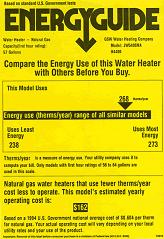That Bright Yellow EnergyGuide Label Will Lead You To Savings
When considering the purchase of a new appliance or HVAC equipment, the more information you have available to you, the better decision you’ll be able to make. A reliable and quickly accessible source of data on energy-consuming products is the EnergyGuide label. The information on these labels can help you estimate how much the equipment will cost to run and whether the item will meet your needs.
The Federal Trade Commission requires EnergyGuide labels be affixed to equipment such as furnaces, window and central air conditioners, heat pumps, water heaters and boilers. You can also find them on large appliances such as freezers, refrigerators, dishwashers and clothes washers.
The EnergyGuide label contains information that allows you to estimate the operating costs of the product and to make comparisons among similar models from the same or different manufacturers. You can find information such as:
- Manufacturer name, equipment size or capacity, and model number.
- Important or desirable features of the equipment.
- Estimated total annual operating cost.
- The upper and lower range of estimated costs for operating similar equipment.
- Estimated kilowatt-hour use over the course of a year.
- The Energy Star logo (if the product qualifies), which indicates the device is Energy Star certified to be energy efficient.
Not all EnergyGuide labels will include the same information. Air conditioner labels, for example, will list the unit’s energy efficiency ratio (EER), which is a measure of the unit’s efficiency during the hottest times. Labels on furnaces include the annual fuel utilization efficiency (AFUE) rating, a measure of furnace efficiency, along with a list of U.S. states where the unit can legally be installed.
With the information from the EnergyGuide label, you can decide if the equipment you’re considering will save money on operating costs. An Energy Star-certified device, for example, should use about a third less energy than a similar non-certified item.
NisAir Air Conditioning and Heating is a leading HVAC provider in Martin, Palm Beach, St. Lucie and Indian River counties, and has been for almost 40 years. Contact us today for more information on how to read the EnergyGuide label and for help interpreting the information it contains.

